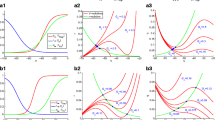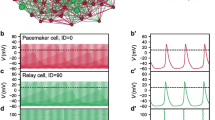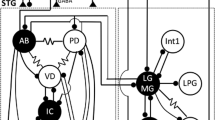Abstract
The intrinsically oscillating neurons in the crustacean pyloric circuit have membrane conductances that influence their spontaneous activity patterns and responses to synaptic activity. The relationship between the magnitudes of these membrane conductances and the response of the oscillating neurons to synaptic input has not yet been fully or systematically explored. We examined this relationship using the phase resetting curve (PRC), which summarizes the change in the cycle period of a neuronal oscillator as a function of the input’s timing within the oscillation. We first utilized a large database of single-compartment model neurons to determine the effect of individual membrane conductances on PRC shape; we found that the effects vary across conductance space, but on average, the hyperpolarization-activated and leak conductances advance the PRC. We next investigated how membrane conductances affect PRCs of the isolated pacemaker kernel in the pyloric circuit of Cancer borealis by: (1) tabulating PRCs while using dynamic clamp to artificially add varying levels of specific conductances, and (2) tabulating PRCs before and after blocking the endogenous hyperpolarization-activated current. We additionally used a previously described four-compartment model to determine how the location of the hyperpolarization-activated conductance influences that current’s effect on the PRC. We report that while dynamic-clamp-injected leak current has much smaller effects on the PRC than suggested by the single-compartment model, an increase in the hyperpolarization-activated conductance both advances and reduces the noisiness of the PRC in the pacemaker kernel of the pyloric circuit in both modeling and experimental studies.














Similar content being viewed by others
References
Angelo, K., & Margrie, T. W. (2011). Population diversity and function of hyperpolarization-activated current in olfactory bulb mitral cells. Scientific Reports, 1, 50. doi:10.1038/srep00050.
Angelo, K., London, M., Christensen, S. R., & Hausser, M. (2007). Local and global effects of I(h) distribution in dendrites of mammalian neurons. The Journal of Neuroscience, 27(32), 8643–8653. doi:10.1523/jneurosci. 5284-06.2007.
Aponte, Y., Lien, C. C., Reisinger, E., & Jonas, P. (2006). Hyperpolarization-activated cation channels in fast-spiking interneurons of rat hippocampus. The Journal of Physiology, 574(Pt 1), 229–243. doi:10.1113/jphysiol.2005.104042.
Ball, J. M., Franklin, C. C., Tobin, A. E., Schulz, D. J., & Nair, S. S. (2010). Coregulation of ion channel conductances preserves output in a computational model of a crustacean cardiac motor neuron. The Journal of Neuroscience, 30(25), 8637–8649. doi:10.1523/JNEUROSCI. 6435-09.2010.
Bose, A., Golowasch, J., Guan, Y., & Nadim, F. (2014). The role of linear and voltage-dependent ionic currents in the generation of slow wave oscillations. Journal of Computational Neuroscience. doi:10.1007/s10827-014-0498-4.
Brown, D. (1988). M currents. In T. Narahashi (Ed.), Ion channels (Vol. 1, pp. 55–99). New York: Plenum.
Brown, G. L., & Eccles, J. C. (1934). The action of a single vagal volley on the rhythm of the heart beat. The Journal of Physiology, 82(2), 211–241.
Chan, C. S., Shigemoto, R., Mercer, J. N., & Surmeier, D. J. (2004). HCN2 and HCN1 channels govern the regularity of autonomous pacemaking and synaptic resetting in globus pallidus neurons. The Journal of Neuroscience, 24(44), 9921–9932. doi:10.1523/JNEUROSCI. 2162-04.2004.
Chen, K., Aradi, I., Thon, N., Eghbal-Ahmadi, M., Baram, T. Z., & Soltesz, I. (2001). Persistently modified h-channels after complex febrile seizures convert the seizure-induced enhancement of inhibition to hyperexcitability. Nature Medicine, 7(3), 331–337. doi:10.1038/85480.
Connor, J. A., Walter, D., & McKown, R. (1977). Neural repetitive firing: modifications of the Hodgkin-Huxley axon suggested by experimental results from crustacean axons. Biophysical Journal, 18(1), 81–102. doi:10.1016/S0006-3495(77)85598-7.
Crook, S. M., Ermentrout, G. B., & Bower, J. M. (1998). Dendritic and synaptic effects in systems of coupled cortical oscillators. Journal of Computational Neuroscience, 5, 315–329.
Dai, A., Temporal, S., & Schulz, D. J. (2010). Cell-specific patterns of alternative splicing of voltage-gated ion channels in single identified neurons. Neuroscience, 168(1), 118–129. doi:10.1016/j.neuroscience.2010.03.001.
Dando, M. R., & Selverston, A. I. (1972). Command fibres from the supra-oesophageal ganglion to the stomatogastric ganglion in Panulirus argus. Journal of Comparative Physiology, 78, 138–175.
Day, M., Carr, D. B., Ulrich, S., Ilijic, E., Tkatch, T., & Surmeier, D. J. (2005). Dendritic excitability of mouse frontal cortex pyramidal neurons is shaped by the interaction among HCN, Kir2, and Kleak channels. The Journal of Neuroscience, 25(38), 8776–8787. doi:10.1523/JNEUROSCI. 2650-05.2005.
Dickinson, P. S., & Marder, E. (1989). Peptidergic modulation of a multioscillator system in the lobster. I. Activation of the cardiac sac motor pattern by the neuropeptides proctolin and red pigment-concentrating hormone. Journal of Neurophysiology, 61(4), 833–844.
Doloc-Mihu, A., & Calabrese, R. L. (2011). A database of computational models of a half-center oscillator for analyzing how neuronal parameters influence network activity. Journal of Biological Physics, 37(3), 263–283. doi:10.1007/s10867-011-9215-y.
Dorval, A. D., Christini, D. J., & White, J. A. (2001). Real-Time linux dynamic clamp: a fast and flexible way to construct virtual ion channels in living cells. Annals of Biomedical Engineering, 29(10), 897–907.
Draper, N., & Smith, H. (1981). Applied regression analysis (2nd ed.). New York: Wiley.
Ermentrout, B., Beverlin, B., & Netoff, T. (2012). Phase response curves to measure ion channel effects on neurons. In N. Schultheiss, A. A. Prinz, & R. J. Butera (Eds.), Phase response curves in neuroscience. New York: Springer.
Flamm, R. E., & Harris-Warrick, R. M. (1986a). Aminergic modulation in lobster stomatogastric ganglion. I. Effects on motor pattern and activity of neurons within the pyloric circuit. Journal of Neurophysiology, 55(5), 847–865.
Flamm, R. E., & Harris-Warrick, R. M. (1986b). Aminergic modulation in lobster stomatogastric ganglion. II. Target neurons of dopamine, octopamine, and serotonin within the pyloric circuit. Journal of Neurophysiology, 55(5), 866–881.
Goaillard, J. M., Taylor, A. L., Schulz, D. J., & Marder, E. (2009). Functional consequences of animal-to-animal variation in circuit parameters. Nature Neuroscience, 12(11), 1424–1430. doi:10.1038/nn.2404.
Goeritz, M. L., Ouyang, Q., & Harris-Warrick, R. M. (2011). Localization and function of Ih channels in a small neural network. Journal of Neurophysiology, 106(1), 44–58. doi:10.1152/jn.00897.2010.
Goldman, M. S., Golowasch, J., Marder, E., & Abbott, L. F. (2001). Global structure, robustness, and modulation of neuronal models. The Journal of Neuroscience, 21(14), 5229–5238.
Golomb, D., & Amitai, Y. (1997). Propagating neuronal discharges in neocortical slices: computational and experimental study. Journal of Neurophysiology, 78(3), 1199–1211.
Golowasch, J., Abbott, L. F., & Marder, E. (1999). Activity-dependent regulation of potassium currents in an identified neuron of the stomatogastric ganglion of the crab Cancer borealis. The Journal of Neuroscience, 19(20), RC33.
Golowasch, J., Goldman, M. S., Abbott, L. F., & Marder, E. (2002). Failure of averaging in the construction of a conductance-based neuron model. Journal of Neurophysiology, 87(2), 1129–1131.
Gutfreund, Y., & Segev, I. (1995). Subthreshold oscillations and resonant frequency in guinea‐pig cortical neurons: physiology and modelling. The Journal of Physiology, 483(3), 621–640.
Harris-Warrick, R. M., Coniglio, L. M., Levini, R. M., Gueron, S. H. A. Y., & Guckenheimer, J. O. H. N. (1995). Dopamine modulation of two subthreshold currents produces phase shifts in activity of an identified motoneuron. Journal of Neurophysiology, 74(4), 1404–1420.
Harris-Warrick, R. M., Johnson, B. R., Peck, J. H., Kloppenburg, P., Ayali, A., & Skarbinski, J. (1998). Distributed effects of dopamine modulation in the crustacean pyloric network. Annals of the New York Academy of Sciences, 860(1), 155–167.
Hille, B. (2001). Ion channels of excitable membranes (Vol. 507). Sunderland: Sinauer.
Hu, H., Vervaeke, K., & Storm, J. F. (2002). Two forms of electrical resonance at theta frequencies, generated by M-current, h-current and persistent Na+ current in rat hippocampal pyramidal cells. The Journal of Physiology, 545(Pt 3), 783–805.
Hudson, A. E., & Prinz, A. A. (2010). Conductance ratios and cellular identity. PLoS Computational Biology, 6(7), e1000838. doi:10.1371/journal.pcbi.1000838.
Huguenard, J. R., & McCormick, D. A. (1992). Simulation of the currents involved in rhythmic oscillations in thalamic relay neurons. Journal of Neurophysiology, 68(4), 1373–1383.
Koch, H., Garcia, A. J., 3rd, & Ramirez, J. M. (2011). Network reconfiguration and neuronal plasticity in rhythm-generating networks. Integrative and Comparative Biology, 51(6), 856–868. doi:10.1093/icb/icr099.
Leys, C., Ley, C., Klein, O., Bernard, P., & Licata, L. (2013). Detecting outliers: Do not use standard deviation around the mean, use absolute deviation around the median. Journal of Experimental Social Psychology, 49(4), 764–766. doi:10.1016/J.Jesp.2013.03.013.
Liu, Z., Golowasch, J., Marder, E., & Abbott, L. F. (1998). A model neuron with activity-dependent conductances regulated by multiple calcium sensors. The Journal of Neuroscience, 18(7), 2309–2320.
Mamiya, A., & Nadim, F. (2004). Dynamic interaction of oscillatory neurons coupled with reciprocally inhibitory synapses acts to stabilize the rhythm period. The Journal of Neuroscience, 24(22), 5140–5150. doi:10.1523/JNEUROSCI. 0482-04.2004.
Maran, S. K., Sieling, F. H., Demla, K., Prinz, A. A., & Canavier, C. C. (2011). Responses of a bursting pacemaker to excitation reveal spatial segregation between bursting and spiking mechanisms. Journal of Computational Neuroscience, 31(2), 419–440. doi:10.1007/s10827-011-0319-y.
Marder, E., & Bucher, D. (2007). Understanding circuit dynamics using the stomatogastric nervous system of lobsters and crabs. Annual Review of Physiology, 69, 291–316. doi:10.1146/annurev.physiol.69.031905.161516.
Marder, E., & Goaillard, J. M. (2006). Variability, compensation and homeostasis in neuron and network function. Nature Reviews Neuroscience, 7(7), 563–574. doi:10.1038/nrn1949.
McCormick, D. A., & Pape, H. C. (1990). Properties of a hyperpolarization-activated cation current and its role in rhythmic oscillation in thalamic relay neurones. The Journal of Physiology, 431, 291–318.
Miller, J. P., & Selverston, A. I. (1982). Mechanisms underlying pattern generation in lobster stomatogastric ganglion as determined by selective inactivation of identified neurons. IV. Network properties of pyloric system. Journal of Neurophysiology, 48(6), 1416–1432.
Mulloney, B., & Selverston, A. I. (1974). Organization of the stomatogastric ganglion of the spiny lobster I. Neurons driving the lateral teeth. Journal of Comparative Physiology, 91, 1–32.
Nadim, F., Booth, V., Bose, A., & Manor, Y. (2003). Short-term synaptic dynamics promote phase maintenance in multi-phasic rhythms. Neurocomputing, 52, 79–87.
Nusbaum, M. P., & Marder, E. (1988). A neuronal role for a crustacean red pigment concentrating hormone-like peptide: neuromodulation of the pyloric rhythm in the crab, Cancer borealis. Journal of Experimental Biology, 135(1), 165–181.
Oprisan, S. A., Thirumalai, V., & Canavier, C. C. (2003). Dynamics from a time series: can we extract the phase resetting curve from a time series? Biophysical Journal, 84(5), 2919–2928. doi:10.1016/S0006-3495(03)70019-8.
Oprisan, S. A., Prinz, A. A., & Canavier, C. C. (2004). Phase resetting and phase locking in hybrid circuits of one model and one biological neuron. Biophysical Journal, 87(4), 2283–2298. doi:10.1529/biophysj.104.046193.
Ouyang, Q., Goeritz, M., & Harris-Warrick, R. M. (2007). Panulirus interruptus Ih-channel gene PIIH: modification of channel properties by alternative splicing and role in rhythmic activity. Journal of Neurophysiology, 97(6), 3880–3892. doi:10.1152/jn.00246.2007.
Peck, J. H., Gaier, E., Stevens, E., Repicky, S., & Harris-Warrick, R. M. (2006). Amine modulation of Ih in a small neural network. Journal of Neurophysiology, 96(6), 2931–2940. doi:10.1152/jn.00423.2005.
Pinsker, H. M. (1977). Aplysia bursting neurons as endogenous oscillators. I. Phase-response curves for pulsed inhibitory synaptic input. Journal of Neurophysiology, 40(3), 527–543.
Pinsker, H. M., & Kandel, E. R. (1977). Short-term modulation of endogenous bursting rhythms by monosynaptic inhibition in Aplysia neurons: effects of contingent stimulation. Brain Research, 125(1), 51–64.
Prinz, A. A., Billimoria, C. P., & Marder, E. (2003a). Alternative to hand-tuning conductance-based models: construction and analysis of databases of model neurons. Journal of Neurophysiology, 90(6), 3998–4015. doi:10.1152/jn.00641.2003.
Prinz, A. A., Thirumalai, V., & Marder, E. (2003b). The functional consequences of changes in the strength and duration of synaptic inputs to oscillatory neurons. The Journal of Neuroscience, 23(3), 943–954.
Prinz, A. A., Abbott, L. F., & Marder, E. (2004a). The dynamic clamp comes of age. Trends in Neurosciences, 27(4), 218–224.
Prinz, A. A., Bucher, D., & Marder, E. (2004b). Similar network activity from disparate circuit parameters. Nature Neuroscience, 7(12), 1345–1352. doi:10.1038/nn1352.
Schultheiss, N. W., Edgerton, J. R., & Jaeger, D. (2010). Phase response curve analysis of a full morphological globus pallidus neuron model reveals distinct perisomatic and dendritic modes of synaptic integration. The Journal of Neuroscience, 30(7), 2767–2782. doi:10.1523/JNEUROSCI. 3959-09.2010.
Schulz, D. J., Goaillard, J. M., & Marder, E. (2006). Variable channel expression in identified single and electrically coupled neurons in different animals. Nature Neuroscience, 9(3), 356–362. doi:10.1038/nn1639.
Schulz, D. J., Goaillard, J. M., & Marder, E. E. (2007). Quantitative expression profiling of identified neurons reveals cell-specific constraints on highly variable levels of gene expression. Proceedings of the National Academy of Sciences of the United States of America, 104(32), 13187–13191. doi:10.1073/pnas.0705827104.
Sharp, A. A., O’Neil, M. B., Abbott, L. F., & Marder, E. (1993a). The dynamic clamp: artificial conductances in biological neurons. Trends in Neurosciences, 16(10), 389–394.
Sharp, A. A., O’Neil, M. B., Abbott, L. F., & Marder, E. (1993b). Dynamic clamp: computer-generated conductances in real neurons. Journal of Neurophysiology, 69(3), 992–995.
Sieling, F. H., Canavier, C. C., & Prinz, A. A. (2009). Predictions of phase-locking in excitatory hybrid networks: excitation does not promote phase-locking in pattern-generating networks as reliably as inhibition. Journal of Neurophysiology, 102(1), 69–84. doi:10.1152/jn.00091.2009.
Sieling, F. H., Archila, S., Hooper, R., Canavier, C. C., & Prinz, A. A. (2012). Phase response theory extended to nonoscillatory network components. Physical Review E: Statistical, Nonlinear, and Soft Matter Physics, 85(5 Pt 2), 056208.
Sober, S. J., & Sabes, P. N. (2003). Multisensory integration during motor planning. The Journal of Neuroscience, 23(18), 6982–6992.
Soofi, W., Archila, S., & Prinz, A. A. (2012). Co-variation of ionic conductances supports phase maintenance in stomatogastric neurons. Journal of Computational Neuroscience, 33(1), 77–95. doi:10.1007/s10827-011-0375-3.
Soto-Trevino, C., Rabbah, P., Marder, E., & Nadim, F. (2005). Computational model of electrically coupled, intrinsically distinct pacemaker neurons. Journal of Neurophysiology, 94(1), 590–604. doi:10.1152/jn.00013.2005.
Stein, W. (2009). Modulation of stomatogastric rhythms. Journal of comparative physiology A Sensory neural and behavioral physiology, 195(11), 989–1009. doi:10.1007/s00359-009-0483-y.
Stiefel, K. M., & Gutkin, B. S. (2012). Cholinergic neuromodulation controls PRC type in cortical pyramidal neurons. In N. W. Schultheiss, A. A. Prinz, & R. J. Butera (Eds.), Phase response curves in neuroscience (pp. 279–306). New York: Springer.
Stiefel, K. M., Gutkin, B. S., & Sejnowski, T. J. (2008). Cholinergic neuromodulation changes phase response curve shape and type in cortical pyramidal neurons. PLoS One, 3(12), e3947. doi:10.1371/journal.pone.0003947.
Swensen, A. M., & Bean, B. P. (2005). Robustness of burst firing in dissociated purkinje neurons with acute or long-term reductions in sodium conductance. The Journal of Neuroscience, 25(14), 3509–3520. doi:10.1523/jneurosci. 3929-04.2005.
Taylor, A. L., Goaillard, J. M., & Marder, E. (2009). How multiple conductances determine electrophysiological properties in a multicompartment model. The Journal of Neuroscience, 29(17), 5573–5586. doi:10.1523/jneurosci. 4438-08.2009.
Temporal, S., Desai, M., Khorkova, O., Varghese, G., Dai, A., Schulz, D. J., et al. (2012). Neuromodulation independently determines correlated channel expression and conductance levels in motor neurons of the stomatogastric ganglion. Journal of Neurophysiology, 107(2), 718–727. doi:10.1152/jn.00622.2011.
Thirumalai, V. (2002). Implications of cotransmission and neuromodulation for neural network function. PhD Thesis, Brandeis University, Waltham, MA.
Thirumalai, V., & Marder, E. (2002). Colocalized neuropeptides activate a central pattern generator by acting on different circuit targets. The Journal of Neuroscience, 22(5), 1874–1882.
Thirumalai, V., Prinz, A. A., Johnson, C. D., & Marder, E. (2006). Red pigment concentrating hormone strongly enhances the strength of the feedback to the pyloric rhythm oscillator but has little effect on pyloric rhythm period. Journal of Neurophysiology, 95(3), 1762–1770.
Tobin, A. E., Cruz-Bermudez, N. D., Marder, E., & Schulz, D. J. (2009). Correlations in ion channel mRNA in rhythmically active neurons. PLoS One, 4(8), e6742. doi:10.1371/journal.pone.0006742.
Tohidi, V., & Nadim, F. (2009). Membrane resonance in bursting pacemaker neurons of an oscillatory network is correlated with network frequency. The Journal of Neuroscience, 29(20), 6427–6435. doi:10.1523/jneurosci. 0545-09.2009.
Tryba, A. K., Pena, F., Lieske, S. P., Viemari, J. C., Thoby-Brisson, M., & Ramirez, J. M. (2008). Differential modulation of neural network and pacemaker activity underlying eupnea and sigh-breathing activities. Journal of Neurophysiology, 99(5), 2114–2125. doi:10.1152/jn.01192.2007.
Tucker, K. R., Huertas, M. A., Horn, J. P., Canavier, C. C., & Levitan, E. S. (2012). Pacemaker rate and depolarization block in nigral dopamine neurons: a somatic sodium channel balancing act. The Journal of Neuroscience, 32(42), 14519–14531. doi:10.1523/jneurosci. 1251-12.2012.
Turrigiano, G., LeMasson, G., & Marder, E. (1995). Selective regulation of current densities underlies spontaneous changes in the activity of cultured neurons. The Journal of Neuroscience, 15(5 Pt 1), 3640–3652.
Vervaeke, K., Hu, H., Graham, L. J., & Storm, J. F. (2006). Contrasting effects of the persistent Na+ current on neuronal excitability and spike timing. Neuron, 49(2), 257–270. doi:10.1016/j.neuron.2005.12.022.
Wilson, C. J., Barraza, D., Troyer, T., & Farries, M. A. (2014). Predicting the responses of repetitively firing neurons to current noise. PLoS Computational Biology, 10(5), e1003612. doi:10.1371/journal.pcbi.1003612.
Yue, C., & Yaari, Y. (2004). KCNQ/M channels control spike afterdepolarization and burst generation in hippocampal neurons. The Journal of Neuroscience, 24(19), 4614–4624. doi:10.1523/JNEUROSCI. 0765-04.2004.
Zhao, S., Golowasch, J., & Nadim, F. (2010). Pacemaker neuron and network oscillations depend on a neuromodulator-regulated linear current. Frontiers in Behavioral Neuroscience, 4, 21. doi:10.3389/fnbeh.2010.00021.
Acknowledgements
We gratefully acknowledge Wanlu Hu for her initial work on this project. We thank Profs. Robert J. Butera, Carmen C. Canavier, Samuel J. Sober, and Wolfgang Stein for advice about experimental design and data analysis, and we further acknowledge Prof. Stein for comments on the manuscript and for verifying a subset of our results (Marine Biological Laboratory, Woods Hole, MA). We thank Dr. Marie Goeritz for helpful discussion of experimental protocols. This work was funded by a National Science Foundation Integrative Graduate Education and Research Traineeship DGE-0333411 (WS), a National Science Foundation Graduate Research Fellowship (WS), and a National Institutes of Health grant R01NS054281 (PI: C. Canavier).
Conflict of interest
The authors declare that they have no conflict of interest.
Author information
Authors and Affiliations
Corresponding author
Additional information
Action Editor: Frances K. Skinner
Electronic supplementary material
Below is the link to the electronic supplementary material.
ESM 1
(GIF 230 kb)
Appendix
Appendix
Rights and permissions
About this article
Cite this article
Soofi, W., Prinz, A.A. Differential effects of conductances on the phase resetting curve of a bursting neuronal oscillator. J Comput Neurosci 38, 539–558 (2015). https://doi.org/10.1007/s10827-015-0553-9
Received:
Revised:
Accepted:
Published:
Issue Date:
DOI: https://doi.org/10.1007/s10827-015-0553-9




